Managing Wildfires Using A Centuries-Old Indigenous Practice
16:07 minutes
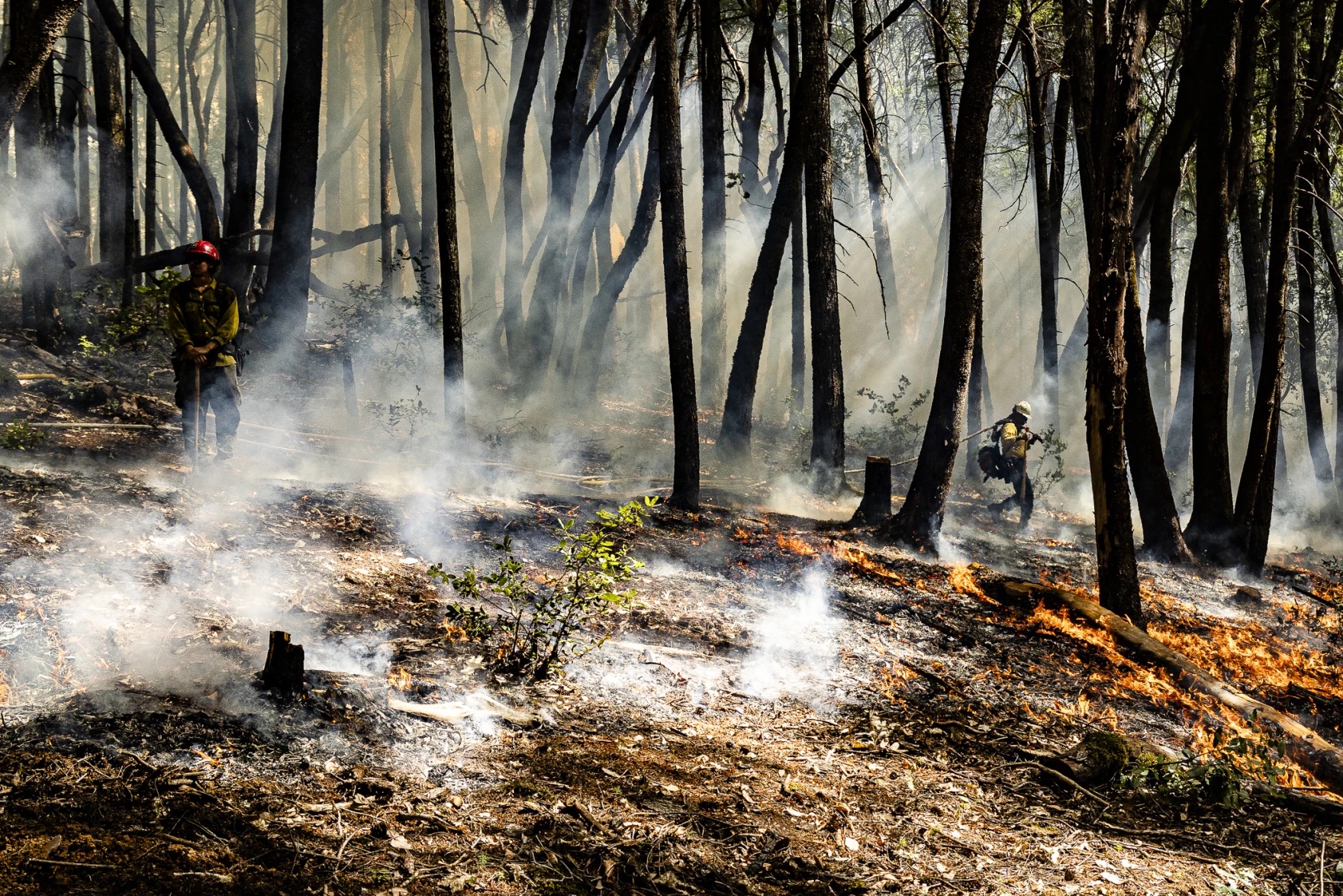

This article is part of The State of Science, a series featuring science stories from public radio stations across the United States. This story, by Murphy Woodhouse, was originally published by Boise State Public Radio.
In late September, firefighters in flame-resistant Nomex were strung out along a fireline. It ran midslope through a pine and hardwood forest above the Klamath River and the small northern California town of Orleans.
Several members of the Karuk tribe were laying down strands of fire with drip torches.
Aja Conrad, who runs the tribal natural resource department’s environmental education field institute, was the firing boss trainee. She kept a close eye as the strips burned together and smoke filled the air.
“Can you just keep an eye on that and maybe not put too much fire below it?” she told one of her burners.
“Copy that.”
Conrad’s grandparents – who helped raise her – worked in fire themselves.
“I grew up kind of a little bit of a fire camp brat living off their snacks and Gatorade and all that,” she said. “So it’s a little bit in my blood in more ways than one.”
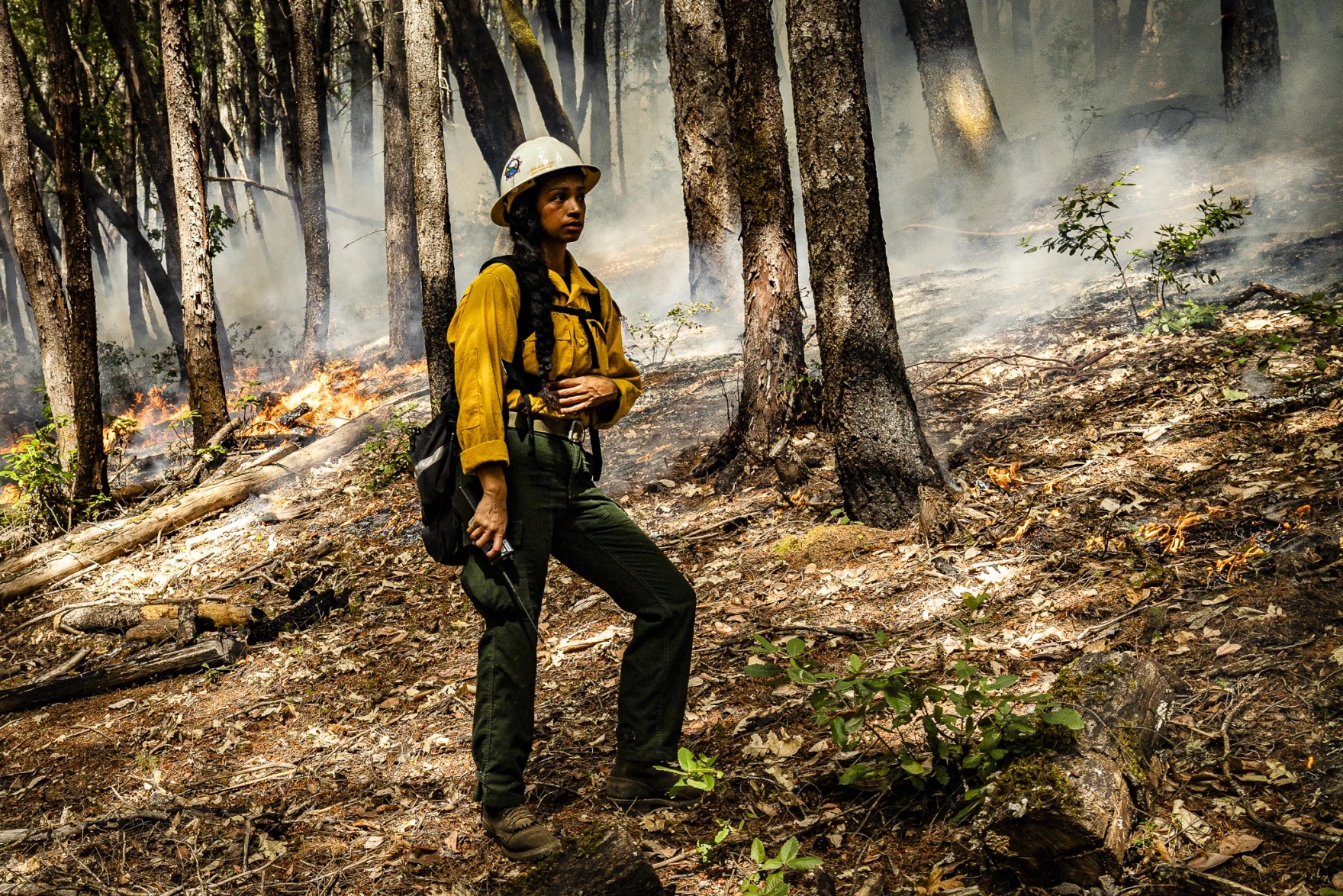
“It’s a real big part of our cultural identity and who we are, and so it feels damn good to be out here doing that,” she said. “It’s not just knowledge for knowledge’s sake. It’s about how to steward this place, it’s about actively, physically tending to this place and rebuilding these sacred relationships.”
The Bacon Flat burn was the first of several during this year’s Klamath Prescribed Fire Training Exchange – or KTREX. Dozens of similar TREX events have been held around the world, training thousands of people since the late 2000s.
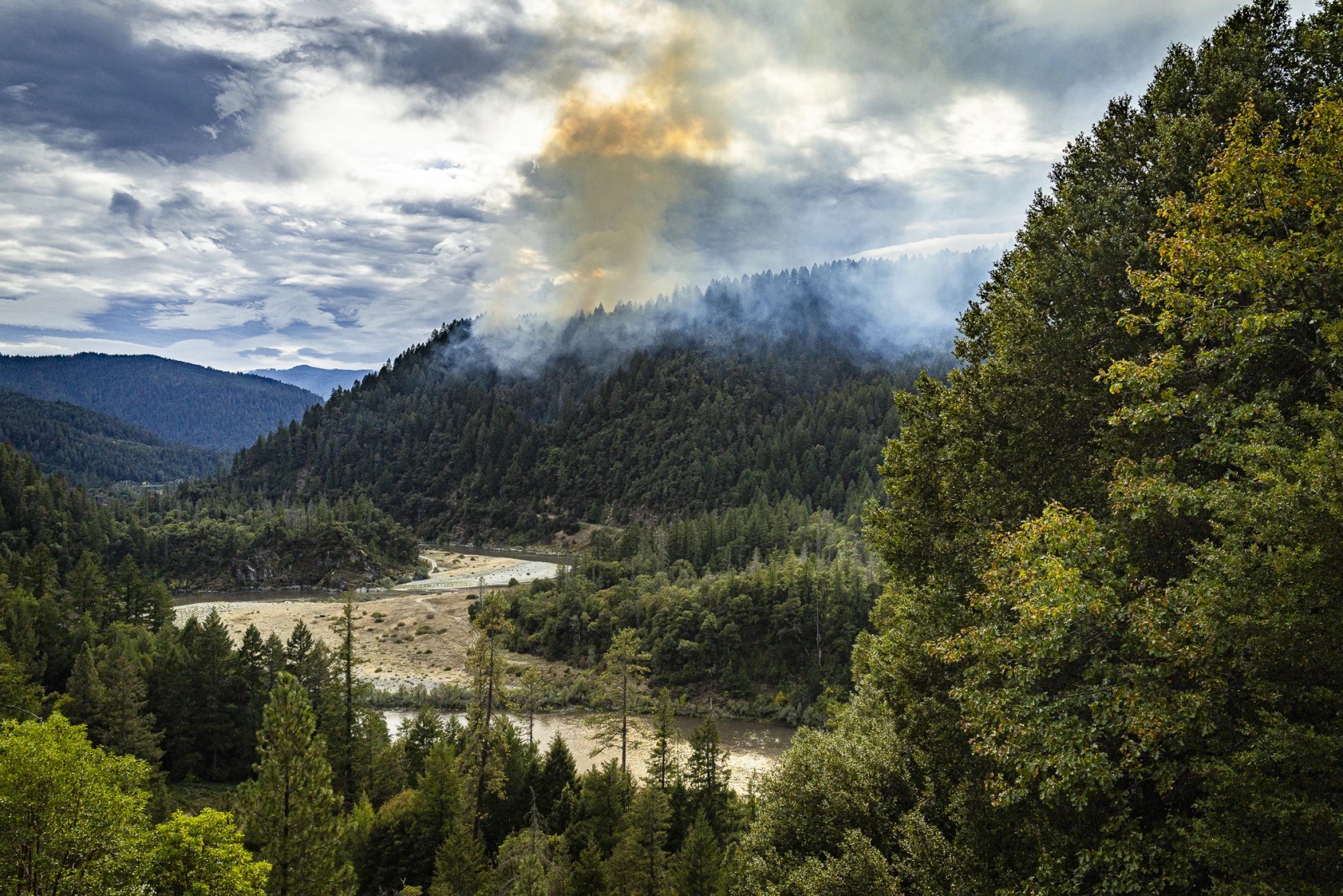
As with many prescribed burns, one of its key purposes was to protect nearby communities from wildfire. But listed right along with that in the burn plan is supporting cultural objectives – like promoting oak woodlands and plant species used for basketry.
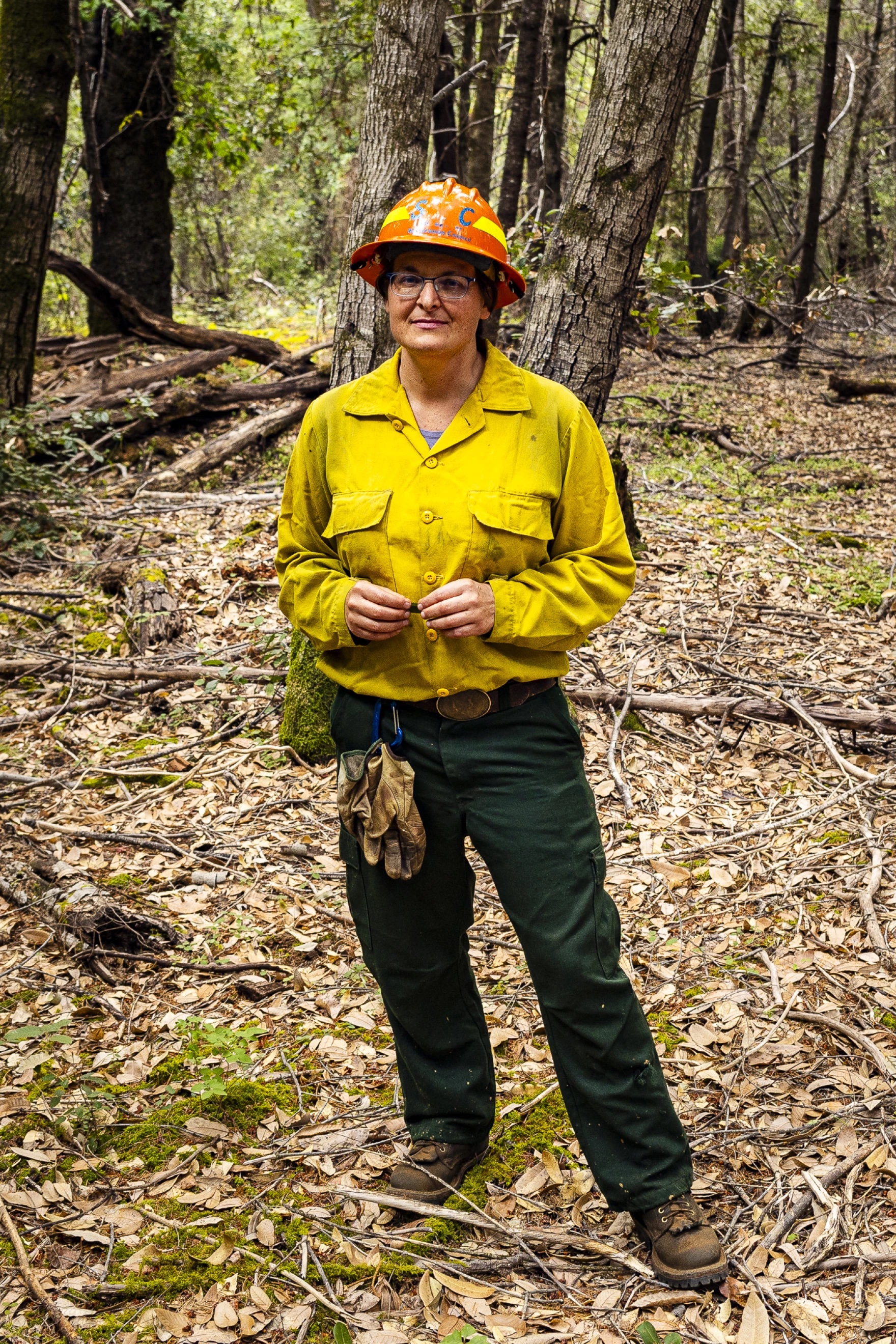
Down at the bottom of the burn, pumps were moving water uphill to help keep flames in check. Posted up nearby was Karuna Greenberg, one of several co-leads of the Western Klamath Restoration Partnership, which puts on the training. The Karuk Tribe itself, the nearby National Forest and several local groups are all part of the effort. Greenberg, who is not a tribal member, said several things distinguish KTREX.
“We are really trying to build a local workforce, building that capacity to even be able to take on wildfire events, to be able to have that capacity here to really scale up our prescribed fire to much more of a landscape level,” she said. “But it’s also just very Indigenous-led. It has such a strong cultural aspect to it.”
Greenberg grew up in the area, and has had a complex journey with fire. In the late 1980s, a major blaze took out her whole neighborhood.
“We were visiting my grandparents on the East Coast and got a phone call that said, ‘you know your house is going to burn. What do you want out of it?’” she recounted.
“I came back to this landscape that was completely changed,” she added. “And it’s hard not to think of fire as this incredibly destructive force.”
But in the wake of the devastation, wildflowers surged back. And then – more slowly – black oak woodlands, berry species and other plants returned, drawing more wildlife back to the area. She described the process as a “rebirth.”
“When you start to pay attention, you can really recognize that fire is a life-giving force,” Greenberg said. “And that switch in your mindset is really transformative.”
The next morning, Greg Moon – the tribe’s fire management officer and incident commander – praised the assembled firefighters for the long, hard shifts they put in the day before.
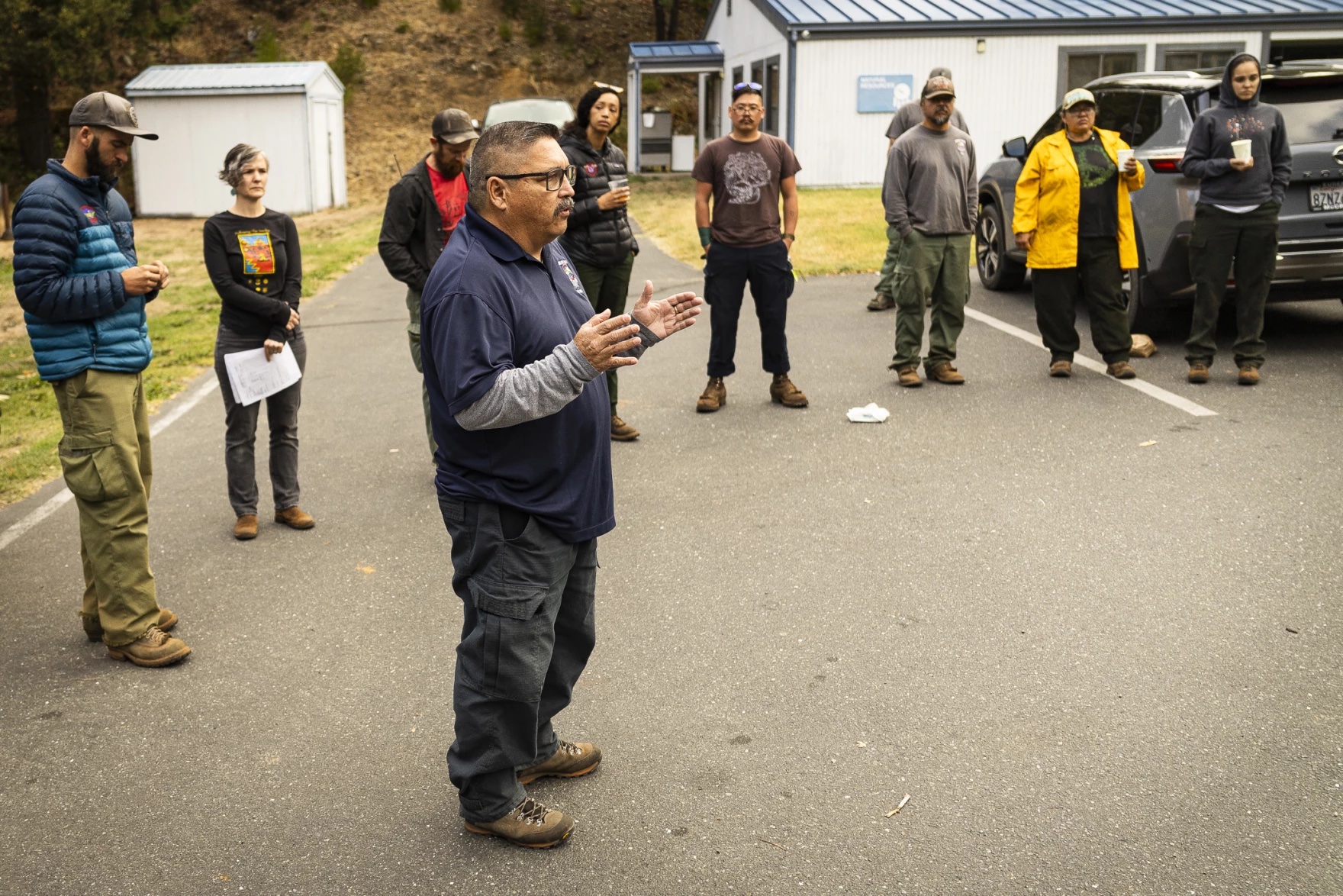
“You guys (can) understand now what you’re doing by building that buffer on the mid slope, and then the units below that, setting us up for success for the next few days,” he said. “So that we can burn a little more liberally, with a little more intention as far as getting those acres.”
“So, I’d like you to just make a fist like this,” he added. “And give your neighbor right there a fist bump.”
In his nearby office at the Karuk Department of Natural Resources, the 36-year fire veteran and member of the nearby Hoopa Valley Tribe said that in KTREX’s early years, they had to bring in people from outside of the area to put on burns.
“Well now, this many years later, our folks are certified, our folks are qualified and they have the experience to pull off these burns as leadership,” he said. “Now, we are at the level where we can start putting these burns on ourselves as a community.”
But capacity is only a part of the equation. He said the Bacon Flat burn was one of the larger KTREX operations to date.
“This one is over 100 acres on very tough land,” he explained. “It’s around structures, and so that tells you that we’ve gained the trust of the community to burn around their property.”
Moon said the Karuk are “leading the way” in Indian Country when it comes to collaborative, community-based burning.
“We learned that we can’t do it alone,” he said. “You could have all the money in the world, but … if you’re by yourself, you can’t do it. So, working with the nonprofits in the community, working with the community itself and the agencies around us, the Karuk Tribe has found a key way to move forward.”
And he sees the idea “spreading across the country.”
For many, KTREX and burns like this are not the end goal, just waypoints en route to something far more ambitious.
Tribal Natural Resources Director Bill Tripp was part of a research team that tried to calculate the scale of pre-colonization burning among his ancestors. They estimated some 7,000 annual ignitions that burned 15% of a large swath of the Karuk’s territory.
“It’s a whole societal system that used to be in place here that we’re trying to get back to some semblance of as soon as we can,” he said.
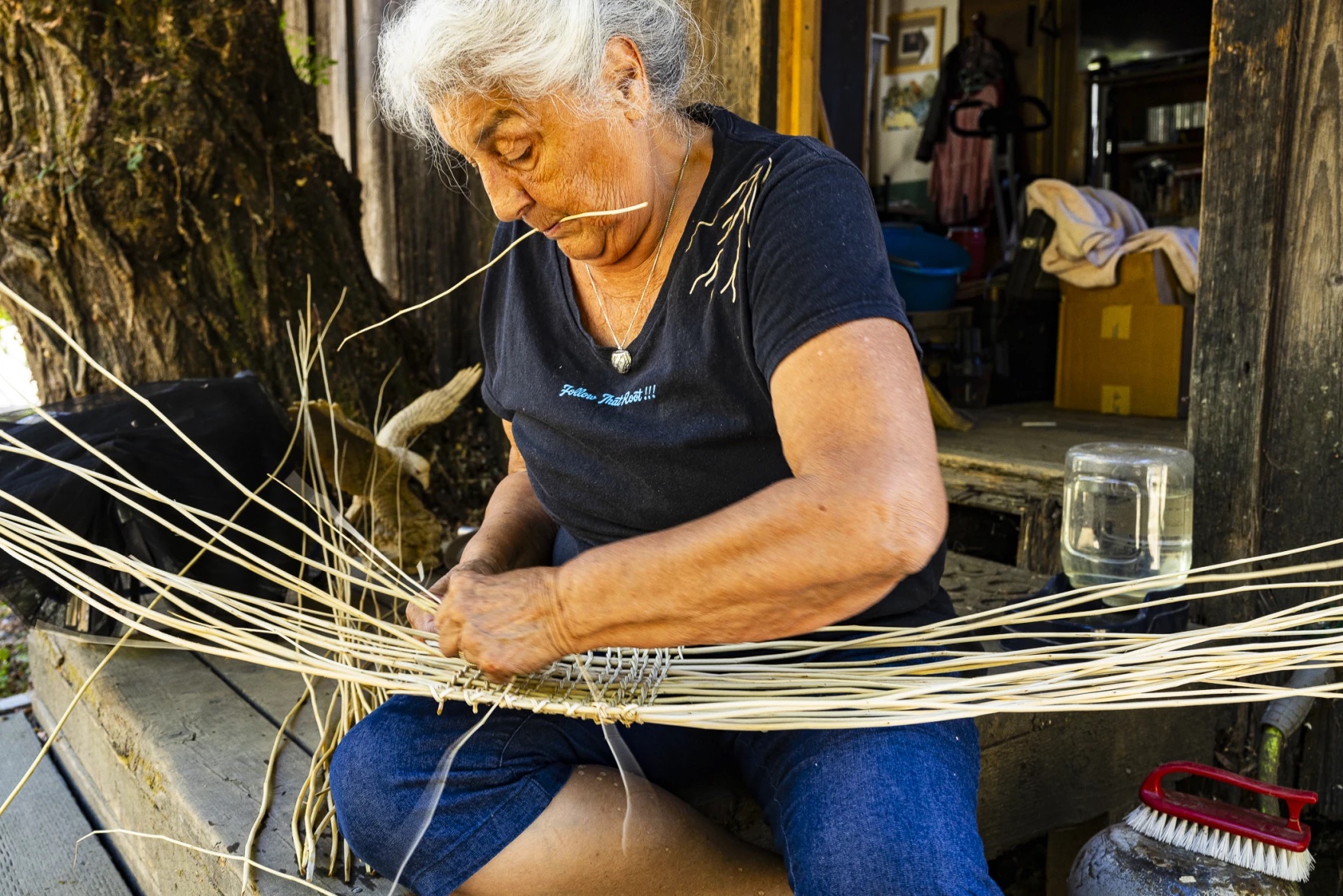
In centuries past, Karuk people – using their deep knowledge of the landscape and climate – would conduct burns solo. That’s a sharp contrast to the dozens of people involved with Bacon Flat.
“The biggest thing that I think people have a hard time grasping is, you know, people perceive that you have to do all these things like build fire lines and … have so many people,” he said. “And in all reality, just a few people could do a lot of really good work with fire just by knowing that hour in the day to light a certain specific type of thing in a certain place.”
He said getting there requires legislative and policy changes, as well as more social acceptance and burning – though he noted that some parts of Karuk territory have seen so much fire in recent years that this sort of burning is starting to look feasible.
In 2022, the California legislature passed a bill establishing a claims fund that could be used for losses that occur during prescribed or cultural burns by nonpublic entities, including “cultural fire practitioners.” Its explicit purpose was to “increase the pace and scale of the use of prescribed fire and cultural burning … and to reduce barriers for conducting prescribed fires and cultural burning.”
And then, shortly after Tripp spoke to the Mountain West News Bureau, California Gov. Gavin Newsom signed Senate Bill 310. It allows the state natural resources agency to enter into written agreements with federally recognized California tribes that would exempt them from state permitting and regulatory requirements for cultural burning.
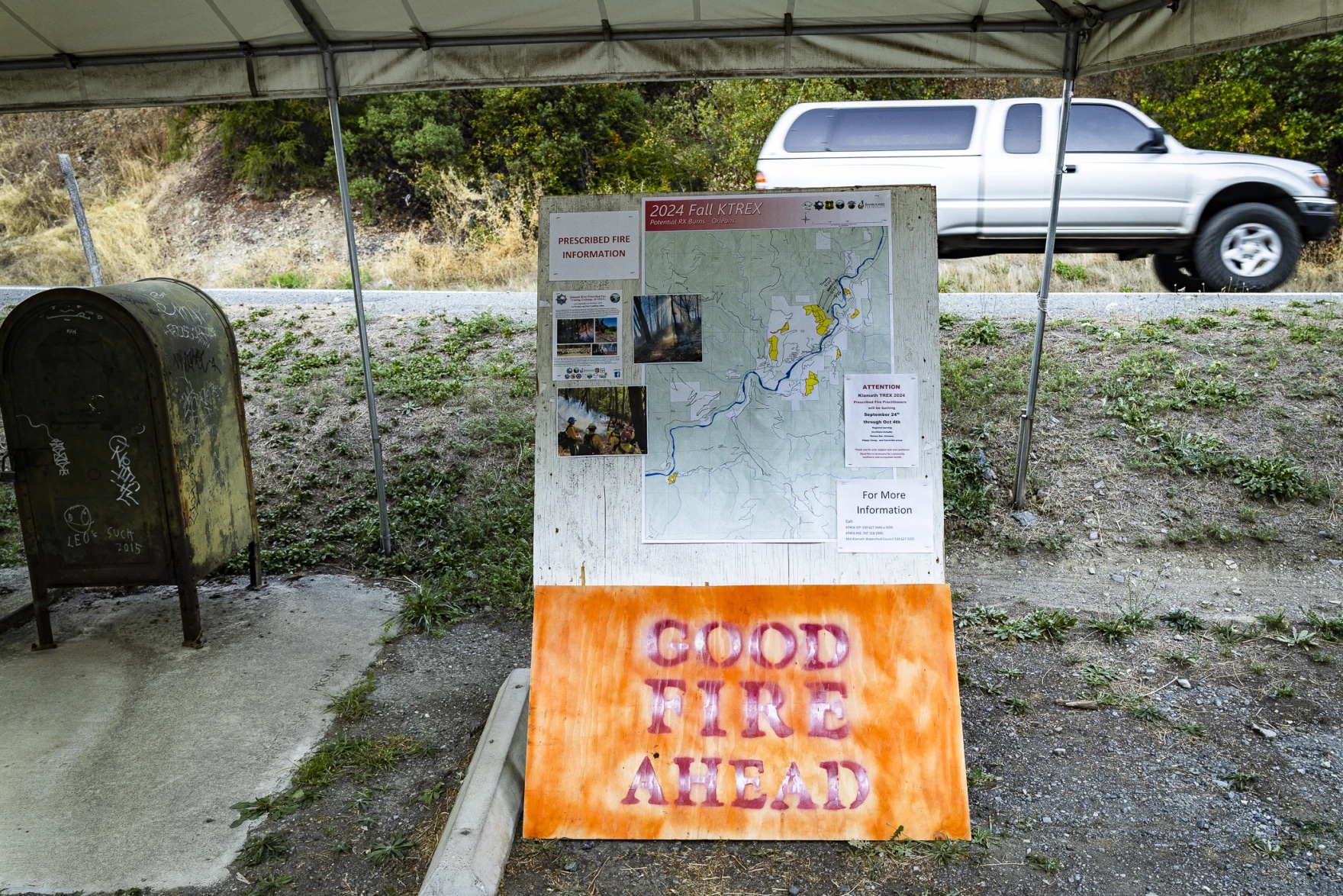
In an opinion piece before its passage, Karuk Chairman Russell Attebery called the measure “an opportunity for California to ‘walk the walk’ when it comes to healing and reconciliation of a violent history towards Indigenous peoples and the misguided exclusion of fire.”
“Imagine if you had two people burning in 20 different places, and burning 3 or 4 acres,” Tripp said of the potential impact of the reforms. “That’s significantly more return on your investment of time and resources. And so having systems in place to back that up and govern that to where it’s not putting others at risk becomes the challenge. That’s where the claims fund comes in, that’s where the in-lieu-of-permit agreement process comes in.”
It’s taken a lot of work to get to where the Karuk are now, and a lot of work remains.
But efforts like KTREX, Tripp said, are “stepping stones.”
Invest in quality science journalism by making a donation to Science Friday.
Murphy Woodhouse is a reporter for Boise State Public Radio and the Mountain West News Bureau in Boise, Idaho.
Bill Tripp is director of Natural Resources and Environmental Policy for the Karuk Nation Department of Natural Resources in Orleans, California.
FLORA LICHTMAN: This is Science Friday. I’m Flora Lichtman. And now it’s time to check in on the state of science.
[AUDIO PLAYBACK]
– This is KERA–
– For WWNO–
– St. Louis Public Radio–
– Iowa Public Radio News.
[END PLAYBACK]
FLORA LICHTMAN: Local science stories of national significance. The Karuk Tribe in northern California has a long history with fire. For millennia, the tribe has managed its land and protected communities from wildfire, in part by using controlled burns. Now the tribe is working with federal agencies and local nonprofits to lead trainings on prescribed burns.
Our next guest reported on a recent burn and is here to tell us all about it. Murphy Woodhouse is a reporter for Boise State Public Radio and the Mountain West News Bureau, based in Boise, Idaho. Murphy, welcome to Science Friday.
MURPHY WOODHOUSE: Really glad to be here.
FLORA LICHTMAN: OK, so for your reporting, you watched a prescribed fire on Karuk tribal land. What should I picture?
MURPHY WOODHOUSE: Yeah, so last fall, I went to northern California, to the small town of Orleans, which sits right on the Klamath River. It’s a very rural, isolated, and just profoundly beautiful part of the state. I was there for what’s called KTREX, or the Klamath River Prescribed Fire Training Exchange. That’s an annual series of burns put on by a coalition, including the Karuk, area nonprofits, and government agencies.
So in a steep pine and hardwood forest above the town, there were dozens of firefighters all strung out along a piece of hand line, and that was marking the intended edge of the burn. The burners, mostly Karuk women, they held a brief ceremony.
And then under the supervision of burn boss trainee Aja Conrad, herself Karuk, they started laying down strands of fire. And what you’re hearing there, that’s the burn slowly chewing through downed branches, leaf litter, and pine needles.
FLORA LICHTMAN: How big an area should I be imagining?
MURPHY WOODHOUSE: This has been described to me as one of the larger burns they’ve done to date, about a hundred acres sitting right above– I mean, you could see the smoke from town and from the river.
FLORA LICHTMAN: Is the Karuk Tribe’s approach, is it different from a prescribed burn managed by the state, for example?
MURPHY WOODHOUSE: Yes. So in many ways, you probably wouldn’t be able to tell them apart. So I did four seasons in wildfire, and what I saw were the same trucks, pumps, hand tools, fire-resistant Nomex-clad firefighters that I’ve seen countless times in the backcountry across the West. The preburn ceremony was an obvious distinction, but I think the key differences really come out in the underlying purposes of the burn, as well as the longer-term strategy that KTREX is a part of.
FLORA LICHTMAN: Well, what are the purposes? What are the benefits of burning?
MURPHY WOODHOUSE: Yeah, I mean, there are just so many reasons to burn. Prescribed fires can reduce fuel loading in forests, and that’s one of the key legacies of decades of suppression-first wildfire policy. And that, in turn, can reduce the risk of extreme wildfire and, of course, the loss of life and property.
FLORA LICHTMAN: That means just sort of getting rid of the brush that’s going to easily catch fire?
MURPHY WOODHOUSE: Absolutely. So just imagine we call them ladder fuels, smaller trees, shrubs, et cetera that can help carry fire up into the crowns of fires and leading to quite destructive, fast-moving, extremely hot, hard-to-fight fires.
So regular fire is just an absolutely essential underpinning of many ecosystems, and that very much includes the Karuk’s ancestral territory. Prescribed fire can help remove invasive species. It can promote the growth of native species and add nutrients to the soil, improve wildlife habitat, but there are also some purposes of this burn and others like it. That’s things like promoting the growth of hazel, which is essential to Karuk basketry, or helping black oak woodlands re-establish, and that’s a critical source of food.
FLORA LICHTMAN: Murphy, what does the law say when it comes to burns like this?
MURPHY WOODHOUSE: So the one that I saw– I mean, prescribed fire trainings like this, they’ve been going on all over and for years. But in California, at least, the law around cultural burns conducted by Indigenous fire practitioners, that’s been shifting in recent years. Some are hopeful that the door could be opening to something that more closely resembles their longstanding traditions. For example, Senate Bill 310 was signed into law, and one of the key elements of that is that it allows the state Natural Resources Agency to enter into written agreements with federally recognized California tribes that would exempt them from state permitting and regulatory requirements for cultural burning.
And shortly before the passage of that bill, Karuk Chairman Russell Attebery called the measure, quote, “an opportunity for California to walk the walk when it comes to healing and reconciliation of a violent history towards Indigenous peoples and the misguided exclusion of fire.”
FLORA LICHTMAN: So you mentioned you were in fire. Are you a former firefighter?
MURPHY WOODHOUSE: Yeah, yeah. So I did– God, at this point, well over a decade ago, I did a season on an engine and then did three seasons on a type one hand crew based out of southeast Idaho.
FLORA LICHTMAN: Did reporting this story change your perspective at all on fire management?
MURPHY WOODHOUSE: I mean, absolutely, and I really feel represented by what Karuna Greenberg told me. She’s a non-native colead with the group that puts on KTREX. So her family lost their home to a major wildfire in the area in the late 1980s, but in the wake of the devastation, native plants and animals surged back, and she described it as a rebirth.
KARUNA GREENBURG: When you start to pay attention, you can really recognize that fire is a life-giving force, and that switch in your mindset is really transformative.
MURPHY WOODHOUSE: So I think it’s pretty clear, and really has been for some time, that we have a quite terrible relationship with wildfire, and I think the tragic LA fires only further highlight this reality. But the Karuk have a time-immemorial tradition of living well with fire and actively using it on their land. And recent research found that something on the order of 7,000 annual ignitions burning some 15% of their territory every single year, that was what was common prior to colonization.
And so for me, the Karuk compellingly show that a different relationship with fire is not only possible but has a history in what we now call the United States measured in centuries.
FLORA LICHTMAN: Thanks, Murphy.
MURPHY WOODHOUSE: Really enjoyed it. Thank you.
FLORA LICHTMAN: That’s Murphy Woodhouse, reporter for Boise State Public Radio and the Mountain West News Bureau, based in Boise, Idaho. The story was recorded for Our Living Lands, a weekly program exploring climate change on tribal lands.
Up next, we’re going to continue this conversation and hear more about the Karuk Tribe’s relationship with fire from tribal member Bill Tripp, who is the director of natural resources and environmental policy for the Karuk. Bill is also an author on a recent study that estimates the scale of precolonial burning by the tribe. We’ll talk about it.
Bill, welcome to Science Friday.
BILL TRIPP: Thanks for having me.
FLORA LICHTMAN: Bill, tell me about the Karuk’s history with fire.
BILL TRIPP: Well, I mean, I’m one of those folks that was being taught how to burn early as four years old. And I was taught the fundamentals, both through our traditional stories, our oral traditions, as well as through being guided in practice at a very early age. We’ve been burning for thousands of years, and so we also have people in our community that have been passing this information down through their families. And so the principles are kind of established. You know what I mean?
FLORA LICHTMAN: Like what?
BILL TRIPP: It’s kind of hard to explain, really, but our stories speak about the responsibilities of the different animals and all the things that they did, and they give you some cues to key in on as you go through practice. And so by the time I was eight years old, I was burning by myself. Adults were indoors, but I was out there by myself burning. And I knew if I had any trouble, I can go in and get some help, but I never did ever need any help.
FLORA LICHTMAN: Who taught you this practice?
BILL TRIPP: Well, from the cultural aspect of it, that was my great-grandmother was a full-blooded Karuk. I was waiting for her to wake up one morning, and so I started. It was kind of cold, so I started to build a fire in the stove. And she heard me and came out and said, well, if you’re going to be playing with fire, you’re going to do something good with it. And she took me outside and gave me a little test to see if I was able to observe my environment and my actions and adjust accordingly. And I passed her test, and so she started telling me the stories and started taking me out there whenever the time was right and just given me the experience I needed.
FLORA LICHTMAN: When you were a little kid learning this, how much land were you burning? What did it look like?
BILL TRIPP: I did a lot of my burning in February and March. And so I didn’t get a whole lot burned. I’d probably get a 10th of an acre to maybe an acre and a half burned in a day. But sometimes I could get that done every day for a two-week period.
And I focused right in close. You can go out underneath a pine tree after two or three days of sun and burn off a layer of pine needles. Around that same time, you can go out in the serpentine where the whitethorn patches are, and there’s just so much fine dead fuel in that. You can burn those clumps off and break up the continuity of all of that fuel. And then a few days later, it’s starting to dry out underneath the oaks, and then you can burn under those. And so it’s a system where you’re creating a little bit of black over here, and then a few days later, you’re able to burn into that black and use that as a control feature. But you just you just have to do which component of the landscape is right in that day, in that time, in that moment.
FLORA LICHTMAN: And that’s what you learn. And is it for land management only, like stewardship of the land, or are there other reasons?
BILL TRIPP: Well, my great-grandmother, she always said that about 80% of our traditional food, fiber, and medicinal resources are fire dependent. When she was young and this was all done by more people more commonly, there was a lot more open space. There was a lot more spring greens and those kinds of things, a lot healthier foods, a lot more people with better materials for their basket-weaving sticks, a lot more smaller deadwood that could be broken and carried back to the home for cooking and heating. And so our relationship with fire connects us to all of these things.
Like live oak, for example, it’s one of those things you go out in February, and you burn underneath the oaks and the live oaks, and you’ll scorch off a lot of these younger live-oak brush. They have really pointy leaves, and that’s a product of them being browsed. And so it’s a protection from ungulates. It’s a really favored browse for large ungulates.
And so if you go out and burn those, they’ll resprout. But if you don’t go and you don’t cut off those dead pieces that have all those dried pointy leaves, they can’t get their nose in there to bite it. And so there’s really intricate relationships there.
It just so happens that time of year, we would use that for pushing lamprey eel to the edge of the river. And so you go and you burn in February or March, and then April, May, June rolls around, and you have all this nice, freshly burned and dried and cured stuff with plenty of leaves that then you can enhance your catch of your lamprey. Then that provides access for large ungulates as they’re moving into their young being born and growing, and it’s just a really high, nutrient-dense resource for them to browse on and have a really good start in life. And then we depend on deer meat and elk meat and other things like that for our food later on in that cycle.
But another interesting thing is by having that browse happen, it will force the stem to grow out and up. And so about five to seven years later, that live-oak branch will be long enough to be used for dip net hoops, and it will be just perfect to where one small little piece can be tied to your A-frame poles that we use for fishing. And then it’ll go out and up and around. And so you could tie the two together, and your net will hold open for another foot wide. And so then you can then enhance your catch of salmon and steelhead.
So it’s all interconnected. So it’s much more than just land management or fire protection, but it does also reduce the amount of fuel loading available during wildfire season.
FLORA LICHTMAN: I was just going to say, I mean, it’s an integral part of a way of life, not just one tool to prevent uncontrolled wildfires, it sounds like.
BILL TRIPP: Yeah, and people underestimate the scale of this activity. Being a way of life like that, it’s when those time frames are upon you, that’s what you go do. It’s hard to get everybody out there doing that these days. You have to develop programs for it or at least develop options to where people can provide for their families in the conduct of doing such. And so we went through and looked at some of these cultural ignitions. We ended up doing a little analysis of the scale in which that practice was historically done, and we came up with a modest estimate of about 7,000 ignitions a year in not that large of an area.
FLORA LICHTMAN: So this was a study that you and your team published looking at the impacts of burning on Karuk land before colonization?
BILL TRIPP: Yeah, and it was kind of a little bit of an attempt to get people to understand the scale of the need. You figure a hundred and some odd villages. Each village just having even a handful of people doing this three, four, five times a year for a couple solid weeks, it amounts to a lot of burning taking place all the time.
FLORA LICHTMAN: Last question. I mean, of course, fires have been national news this month, last month. Watching these fires in LA, how did they strike you? Did you feel like there were lessons that you wish people would learn from Karuk practices that could be applied here?
BILL TRIPP: Well, I think people have a lot to learn. I went and spent a little time down in LA a year or so ago. And man, driving around in some of that country, it was just like, oh boy. People are going to have a wake-up call here eventually. When the conditions align with the weather event and that ignition, it’s trouble.
And it’s not just LA, you know? I mean, you’re seeing places like Santa Rosa burning in that way a couple times. You’ve got communities all over the place that are burning down. The Slater Fire in 2020 took out 200 homes in Happy Camp in our aboriginal territory, and all of that is trying to come back into an oak woodland type of condition, which is the type of condition that we need to be able to do our cultural burning practices and have our cultural resources in place. But it’s not going to get there on its own. It needs our help.
FLORA LICHTMAN: Bill Tripp is a member of the Karuk Tribe and its director of natural resources and environmental policy. He’s based in Orleans, California. Thank you for joining us.
BILL TRIPP: Yeah, thank you.
Copyright © 2025 Science Friday Initiative. All rights reserved. Science Friday transcripts are produced on a tight deadline by 3Play Media. Fidelity to the original aired/published audio or video file might vary, and text might be updated or amended in the future. For the authoritative record of Science Friday’s programming, please visit the original aired/published recording. For terms of use and more information, visit our policies pages at http://www.sciencefriday.com/about/policies/
Kathleen Davis is a producer and fill-in host at Science Friday, which means she spends her weeks researching, writing, editing, and sometimes talking into a microphone. She’s always eager to talk about freshwater lakes and Coney Island diners.
Flora Lichtman is a host of Science Friday. In a previous life, she lived on a research ship where apertivi were served on the top deck, hoisted there via pulley by the ship’s chef.